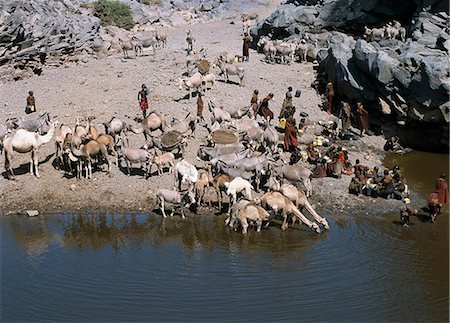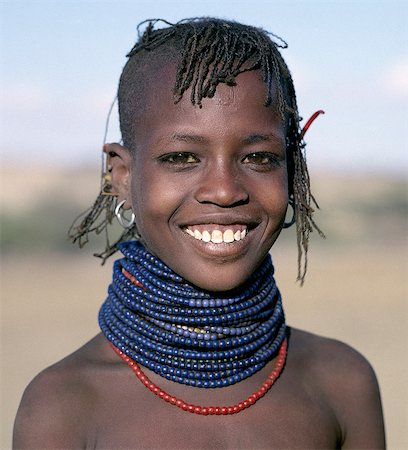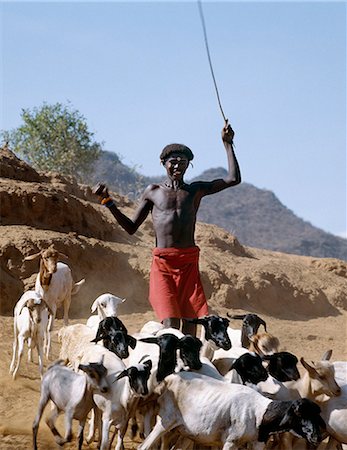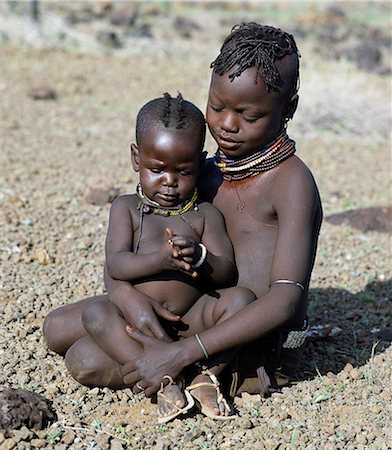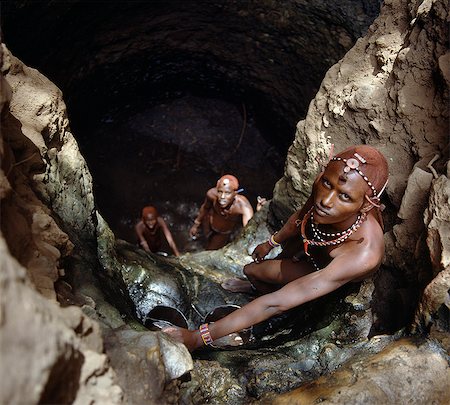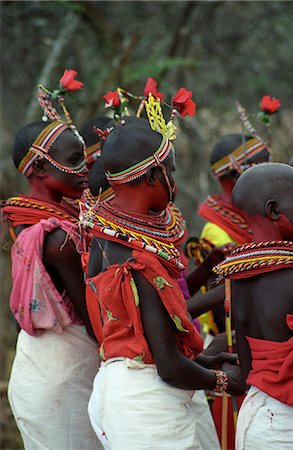-
Turkana women and girls are responsible for watering livestock,which is unusual among pastoral societies. Here,a young girl waters goats from a waterhole dug in the sand of a seasonal watercourse. Her young brother will control the flow of stock to the water trough. In the background,a man digs out another waterhole; they have to been deepened regularly towards the end of the dry season.
Con derechos protegidos
-
Turkana women and girls are responsible for watering livestock,which is unusual among pastoral societies. Here,a girl waters cattle from a Waterhole dug in the sand of a seasonal watercourse. The Turkana manipulate the horns of their ox's into perfect symmetry or any whimsical shape that takes the owner's fancy.
Con derechos protegidos
-
Turkana girls return home from a Waterhole with water containers made of wood. Their cloaks are goatskin embellished with glass beads.
Con derechos protegidos
-
A young Turkana girl wearing an attractively beaded leather apron and belt stands outside her mother's home. Sansevieria or wild sisal lines the lower walls of the house. Cicatrization round the nipples of a girl is not an uncommon form of beautification.
Con derechos protegidos
-
Two Turkana girls set off to fetch water from a nearby Waterhole. Their water containers are made of wood by the women of the tribe. Their 'V' shaped aprons are made of goatskin and have been edged with hundreds and hundreds of round discs fashioned out of ostrich eggshells.
Con derechos protegidos
-
A Turkana girl in all her finery. Among the Turkana,cicatrization is a common form of beautification. She wears a crucifix given to her by a missionary; they are popular ornaments despite not necessarily being associated with Christianity.
Con derechos protegidos
-
A Turkana woman wears all the finery of her tribe: brass lip plug,beaded collar decorated with bleached shells of the African land snail,leaf-like ear ornaments and metal earrings from which hang tiny rings of goat horn.
Con derechos protegidos
-
A jovial group of Turkana girls in traditional attire. Their aprons are made of goatskin,either beaded or cut into thin strips before braiding. The two girls in the middle have already had the flesh below their lower lips pierced in readiness for a brass ornament after marriage.
Con derechos protegidos
-
The natural rock pools along the Sirima lugga (seasonal watercourse) are important to the Turkana and their livestock in an otherwise waterless,rocky region at the southern end of Lake Turkana. In a year of average rainfall,water in the deepest pools will last throughout the year. If they dry up,the Turkana resort to using the alkaline water of Lake Turkana.
Con derechos protegidos
-
The natural rock pools along the Sirima lugga (seasonal watercourse) are important to the Turkana and their livestock in an otherwise waterless,rocky region at the southern end of Lake Turkana. In a year of average rainfall,water in the deepest pools will last throughout the year. If they dry up,the Turkana resort to using the alkaline water of Lake Turkana.
Con derechos protegidos
-
The natural rock pools along the Sirima lugga (seasonal watercourse) are important to the Turkana and their livestock in an otherwise waterless,rocky region at the southern end of Lake Turkana. In a year of average rainfall,water in the deepest pools will last throughout the year. If they dry up,the Turkana resort to using the alkaline water of Lake Turkana.
Con derechos protegidos
-
When a Turkana woman gives birth,four goats will be slaughtered in a twenty-four-hour period to celebrate the occasion. The skin of the first goat will be made into a pouch for carrying the baby on its mother's back. The small wooden balls on the back of this pouch are charms to ward off evil spirits. The baby is wearing a bracelet of ostrich eggshell beads.
Con derechos protegidos
-
In the semi-arid terrain of Turkanaland,women have to travel great distances to collect firewood. Like other Nilotic people,Turkana women balance heavy loads on their heads with graceful carriage and poise. The attire of this woman is typical of married women in the tribe.
Con derechos protegidos
-
A Samburu Warrior drives his goats along the wide,sandy seasonal watercourse of the Milgis where waterholes dug by the Samburu in the dry season are a lifeline for pastoralists in this semi-arid region of their district.
Con derechos protegidos
-
A proud Turkana father and his young daughter. Both their hairstyles are typical of tribal custom in the west of Turkanaland.
Con derechos protegidos
-
A pretty young Turkana girl has already had the flesh below her lower lip pierced in readiness for a brass ornament after her marriage. The rims of her ears have also been pierced and the holes kept open with small wooden sticks.
Con derechos protegidos
-
A young Turkana girl adorned with necklaces of a style the Southern Turkana prefer to wear.
Con derechos protegidos
-
A young Turkana girl has had the rims of her ears pierced in seven places and keeps the holes open with small wooden sticks. After marriage,she will hang leaf-shaped metal pendants from each hole.
Con derechos protegidos
-
A Turkana girl's necklaces are well-oiled with animal fat and glisten in the sun. Occasionally,a girl will put on so many necklaces that her vertebrae stretch and her neck muscles gradually weaken. The partially shaven head is typical of Turkana women and girls.
Con derechos protegidos
-
A Turkana girl's necklaces are well-oiled with animal fat and glisten in the sun. The use of red ochre has been copied from their Samburu neighbours and is not widespread. Occasionally,a girl will put on so many necklaces that her vertebrae stretch and her neck muscles gradually weaken. The partially shaven head is typical of Turkana women and girls.
Con derechos protegidos
-
A young Samburu herdsman drives goats towards a Waterhole along the Milgis - a wide,sandy seasonal watercourse which is a lifeline for pastoralists in the low-lying semi-arid region of their district. The hair style of the young man denotes his status as an uncircumcised youth.
Con derechos protegidos
-
Maasai pastoralists water their livestock at the seasonal Sanjan River,which rises in the Gol Mountains of northern Tanzania.
Con derechos protegidos
-
Shaded from the hot sun, a Karo woman grinds sorghum using large flat stones.It is customary for females of the tribe when in their teens to make a small hole in the flesh below their lower lips into which they put an ornament, this woman has used a small nail. Numerous heavy metal bracelets are worn by married womenThe Karo are a small tribe living in three main villages along the lower reaches o
Con derechos protegidos
-
A young Galla herdsboy with his family's cattle outside their homestead.
Con derechos protegidos
-
A Turkana herdsboy sneaks a drink of milk from a fat-tailed ewe.
Con derechos protegidos
-
Childhood is brief in nomadic communities. From an early age,Turkana girls help their mothers with the household chores and look after their younger brothers and sisters during the day. The baby has wooden charms round her neck to ward off evil spirits.
Con derechos protegidos
-
A Maasai warrior and a young herdsboy draw water for livestock from the deep wells at Naberera where cattle paths are cut deep into the soil to allow livestock nearer to the source of water.
Con derechos protegidos
-
Deep Maasai wells at Loibor Serrit where cattle paths are cut deep into the soil to allow livestock nearer to the source of water. Despite this immense amount of manual labour.Four fit, young men are necessary to bring water to the stock troughs about 30 feet above the water level at the bottom of the hand dug wells.
Con derechos protegidos
-
A Dassanech man stands on one leg in typical pose while looking after his familys cattle in the Omo Delta, one of the largest inland deltas in the world. The extensive scarification on his chest and shoulders denotes that he has killed an enemy.They practice animal husbandry and fishing as well as agriculture.
Con derechos protegidos
-
A Dassanech man stands on one leg in typical pose while looking after his familys cattle in the Omo Delta, one of the largest inland deltas in the world. The extensive scarification on his chest and shoulders denotes that he has killed an enemy.They practice animal husbandry and fishing as well as agriculture.
Con derechos protegidos
-
Song is an art form ingrained in Turkana culture. At the end of a dance session,the participants invariably enjoy the Song of the Bulls. Each young man will take centre-stage to extol the praises of his favourite ox. He will explain how it came into his possession,its distinguishing traits and with outstretched arms,imitate the shape of its horns.
Con derechos protegidos
-
Black ostrich feathers decorate the front part of this Turkana man's traditional clay hairdo. Small metal chains,with or without beads attached to the ends of them,are commonplace ear ornaments.
Con derechos protegidos
-
In the early morning,young Samburu girls take kids to their mothers. They will then milk the nanny goats leaving half the milk for the kids. Only women and children milk goats although every member of the family will drink the milk.
Con derechos protegidos
-
In the early morning,a young Samburu girl takes a kid to its mother. She will then milk the nanny goat leaving half the milk for the kid. Only women and children milk goats although every member of the family will drink the milk.
Con derechos protegidos
-
A Samburu girl drives her family's flocks of fat-tailed sheep and goats to grazing grounds after her brothers have watered them from wells dug in the Milgis - a wide,sandy seasonal watercourse that is a lifeline for Samburu pastoralists in the low-lying,semi-arid region of their land.
Con derechos protegidos
-
Maasai livestock watering at the seasonal Sanjan River,which rises in the Gol Mountains of northern Tanzania.
Con derechos protegidos
-
Maasai livestock watering at the seasonal Sanjan River,which rises in the Gol Mountains of northern Tanzania.
Con derechos protegidos
-
A Datoga woman relaxes outside her thatched house.The traditional attire of Datoga women includes beautifully tanned and decorated leather dresses and coiled brass armulets and necklaces. Extensive scarification of the face with raised circular patterns is not uncommon among women and girls.
Con derechos protegidos
-
A Karo woman with her face painted in preparation for a dance in the village of Duss. A small Omotic tribe related to the Hamar, who live along the banks of the Omo River in southwestern Ethiopia, the Karo are renowned for their elaborate body painting using white chalk, crushed rock and other natural pigments. She is wearing a goatskin apron and carries a leather belt decorated with cowrie shells
Con derechos protegidos
-
A Karo women stands in the doorway to her hut in the village of Duss. A small Omotic tribe related to the Hamar, who live along the banks of the Omo River in southwestern Ethiopia, the Karo are renowned for their elaborate body painting using white chalk, crushed rock and other natural pigments. In addition to painting her face she has decorated her body with whorls of goat hair tied by leather co
Con derechos protegidos
-
A Nyangatom woman wears multiple layers of beads in necklaces, an elaborately beaded calfskin skirt and metal bracelets, amulets and anklets. She is standing beside a temporary beehive construction of sticks, grass and leaves built to provide shade for her goats. The Nyangatom or Bume are a Nilotic tribe of semi-nomadic pastoralists who live along the banks of the Omo River in south western Ethio
Con derechos protegidos
-
An old Dassanech woman prepares her fields beside the Omo River with a digging stick in readiness to plant sorghum. This crude form of agricultural implement is in common use in this remote part of Ethiopia.
Con derechos protegidos
-
Up to a year before his circumcision,a Samburu boy will style his hair is a distinctive 'pudding bowl' shape and often rub charcoal and fat into it.Uncircumcised boys are considered children whatever their age. They have no standing in the tribe and do not belong to an age-set..
Con derechos protegidos
-
A close-up of a Pokot woman's earrings,hairstyle and beaded ornaments. Only married women wear brass earrings and glass-beaded collars. The band over her head supports the weight of her heavy earrings.
Con derechos protegidos
-
A young married woman of the Pokot tribe. Her married status is denoted by her large brass earrings and broad beaded collars and necklaces that are smeared with animal fat to glisten in the sun.
Con derechos protegidos
-
A young Pokot girl in traditional attire. Girls wear leather skirts and capes made from home-tanned goatskins. Her broad necklaces are made from small segments of sedge grass. Her ears have already been pierced in four places,ready to insert the large brass earrings she will acquire after marriage.
Con derechos protegidos
-
A Maasai warrior resplendent with his long ochred braids tied in a pigtail watches over his family's cattle,spear in hand. The singular hairstyle of warriors sets them apart from other members of their society.
Con derechos protegidos
-
Song is an art form ingrained in Turkana culture. At the end of a dance session,the participants invariably enjoy the Song of the Bulls. Each young man will take centre-stage to extol the praises of his favourite ox. He will explain how it came into his possession,its distinguishing traits and with outstretched arms,imitate the shape of its horns.
Con derechos protegidos
-
Song is an art form ingrained in Turkana culture. After months of separation,young men and girls gather together during the rains when grass is abundant and life is relatively easy for a while. The Turkana have a rich repertoire of at least twenty dances,most of which are quite energetic.
Con derechos protegidos
-
Song is an art form ingrained in Turkana culture. At the end of a dance session,the participants invariably enjoy the Song of the Bulls. Each young man will take centre-stage to extol the praises of his favourite ox. He will explain how it came into his possession,its distinguishing traits and with outstretched arms,imitate the shape of its horns.
Con derechos protegidos
-
Childhood is brief in nomadic communities. From an early age,Turkana girls help their mothers with the household chores,while boys learn to look after the small stock. There are only short periods in a day when children can relax and play.
Con derechos protegidos
-
A Samburu woman milks a camel at her homestead in the early morning. The proximity of the calf helps to stimulate the flow of milk. Baby camels have a wool-like texture to their coats,which they lose after six month.
Con derechos protegidos
-
A young Maasai herdsboy controls his family's cattle at the Sanjan River to prevent too many animals watering at the same time.
Con derechos protegidos
-
Two young Datoga men work wells on the east side of Lake Manyara to water their family's livestock. The man who draws water balances precariously on two poles.The Datoga (known to their Maasai neighbours as the Mang'ati and to the Iraqw as Babaraig) live in northern Tanzania and are primarily pastoralists.
Con derechos protegidos
-
A Datoga woman relaxes outside her thatched house.The traditional attire of Datoga women includes beautifully tanned and decorated leather dresses and coiled brass armulets and necklaces.The Datoga live in northern Tanzania and are primarily pastoralists.
Con derechos protegidos
-
A Mursi woman wearing a large clay lip plate. Shortly before marriage, a girls lower lip will be pierced and progressively stretched over a year or so. The size of the lip plate often determines the quantum of the bride price. They live in a remote area of southwest Ethiopia along the Omo River, the country's largest river.
Con derechos protegidos
-
A Mursi woman wearing a large wooden lip plate. Shortly before marriage, a girls lower lip will be pierced and progressively stretched over a year or so. The size of the lip plate often determines the quantum of the bride price. They live in a remote area of southwest Ethiopia along the Omo River.
Con derechos protegidos
-
An old Kikuyu lady picks coffee.Taken in the 1960's,this photograph depicts a traditional form of dress and ear ornaments among Kikuyu women,which has completely disappeared.
Con derechos protegidos
-
Up to a year before his circumcision,a Samburu boy will style his hair in a distinctive 'pudding bowl' shape and often rub charcoal and fat into it.Uncircumcised boys are considered children whatever their age. They have no standing in the tribe and do not belong to an age-set.
Con derechos protegidos
-
Maasai warriors draw water from a deep well. The depth of wells is measured by the number of men required to bring water to the cattle troughs at the top of them. A three-man well will be about 24 feet deep since the buckets are thrown between the men in a rhythmic chant.
Con derechos protegidos
-
A Maasai elder herds his cattle near the foothills of Ol doinyo Orok (the Black Mountain).
Con derechos protegidos
-
The traditional weaponry of the Turkana warriors consisted of a long-shafted spear with a narrow blade,a small rectangular shield made of giraffe or buffalo hide,a wrist knife worn round the assailant's right wrist and one or two finger knives for gouging out an enemy's eyes. They must have been an awesome sight in full battle cry. Modern arms have now replaced the old ways of fighting.
Con derechos protegidos
-
Two Turkana men in traditional attire relax in the heat of the day under a shady tree. Every man will have a wooden stool,which doubles up as a pillow at night to protect his clay hairdo. Men will never sit on the ground; only women and children are permitted to do so.
Con derechos protegidos
-
During Samburu wedding celebrations,warriors resplendent with long Ochred braids dance with young girls who have put on all their finery for the occasion. Both warriors and girls smear their faces,necks and shoulders with red ochre mixed with animal fat to enhance their appearance. Two spears are tipped with ostrich-feather pompoms.
Con derechos protegidos
-
A young Maasai herdsboy drives his family's herds to grazing grounds close to the Sanjan River in Northern Tanzania.
Con derechos protegidos
-
A Maasai warrior drives his family's cattle to the Sanjan River in northern Tanzania
Con derechos protegidos
-
Two Maasai warriors,spears on their shoulders,leave the friable dusty banks of the Sanjan River after watering their cattle.
Con derechos protegidos
-
Maasai herdsmen drive their cattle home in the late afternoon over the dusty volcanic soil at the base of the western wall of the Gregory Rift,which dominates the landscape in this remote corner of northern Tanzania.
Con derechos protegidos
-
A Dassanech woman winnows grain by pouring it from her metal tin and letting it fall onto a calfskin. Much the largest of the tribes in the Omo Valley numbering around 50,000,the Dassanech (also known as the Galeb,Changila or Merille) and Nilotic pastoralists and agriculturalists.
Con derechos protegidos
-
A young Maasai girl wears a headband decorated with chains and cowrie shells that signifies her recent circumcision. Clitodectomy was commonly practiced by the Maasai but it is now gradually dying out.
Con derechos protegidos
-
Detail of a Maasai warrior's ear ornaments and other beaded or metal adornments. The Maasai practice of piercing ears in adolescence and gradually elongating the lobes is gradually dying out. This warrior's body and his long braids have been smeared with red ochre mixed with animal fat.
Con derechos protegidos
-
A Datoga young man in traditional attire.His braids are embellished with beads and aluminium can openers.Many of his white plastic bracelets are beautifully decorated with abstract and geometrical designs; long ago these bracelets would have been made of ivory.
Con derechos protegidos
-
Samburu girls are given strings of beads by their fathers when they are still young. As soon as they are old enough to have lovers from the warrior age set, they regularly receive gifts from them.Over a period of years, their necklaces can smother them up to their necks.
Con derechos protegidos
-
Hamar women dance around cattle at a Jumping of the Bull ceremony as a rainbow gives colour to a threatening sky overhead.The Hamar are semi nomadic pastoralists of Southwest Ethiopia whose women wear striking traditional dress and style their red ochre hair mop fashion.The phallic protrusion of the women's chokers denote they are their husbands first wives.The Jumping of the Bull ceremony is a ri
Con derechos protegidos
-
A young Nyangatom woman carries her baby on her hip in an elaborately braided papoose. Her hair has been reddened with a mixture of ochre and animal fat. Typical of her tribe, she wears a calfskin skirt, multiple layers of bead necklaces and metal bracelets and amulets. The Nyangatom or Bume are a Nilotic tribe of semi nomadic pastoralists who live along the banks of the Omo River in south western
Con derechos protegidos
-
A Nyangatom woman stands with her baby on her hip beside her grass hut in his temporary camp. Nyangatom married women wear elaborately beaded skirts which reach the ground at the back and often have panels of different coloured calkfskin sewn into the tail The Nyangatom or Bume are a Nilotic tribe of semi nomadic pastoralists who live along the banks of the Omo River in south western Ethiopia.
Con derechos protegidos
-
A Karo mother and child. Heavy metal bracelets are common among older women.The Karo are a small tribe living in three main villages along the lower reaches of the Omo River in southwest Ethiopia.
Con derechos protegidos
-
A Samburu woman sews a leather cloak for her younger brother. For several weeks before a boy is circumcised,he must wear a charcoal-blackened cloak,which is made from three goatskins.
Con derechos protegidos
-
A Turkana woman sitting in the doorway of her hut. Her heavy mporro braided necklace identifies her as a married woman. Typical of her tribe,she wears many layers of bead necklaces and a beaded headband.
Con derechos protegidos
-
A Turkana woman sitting in the doorway of her hut. Her heavy mporro braided necklace identifies her as a married woman. Typical of her tribe,she wears many layers of bead necklaces and a beaded headband.
Con derechos protegidos
-
A Turkana woman,typically wearing many layers of bead necklaces and a series of hooped earrings with an pair of leaf-shaped earrrings at the front,sits in the entrance to her hut.
Con derechos protegidos
-
A Turkana woman,typically wearing many layers of bead necklaces and a series of hooped earrings with an pair of leaf-shaped earrrings at the front,sits in the entrance to her hut.
Con derechos protegidos
-
An old Turkana woman,typically wearing many layers of bead necklaces and a series of hooped earrings with an pair of leaf-shaped earrings at the front.
Con derechos protegidos
-
Gabbra women sing and dance to celebrate a wedding. The traditional metal ornamentation on their heads is called malmal.
Con derechos protegidos










